It’s that time again! As I write this, my school district is gearing up to administer the annual WIDA ACCESS tests. For those who live in states that are part of the WIDA Consortium, this test is the most important assessment of multilingual learners’ growth in English proficiency. Score results inform program eligibility, class placement, instructional groupings, learning supports, and more. I’m here to help you gain a clearer view of the test itself. I also have some tips for how any teacher working with multilingual learners can support the test prep process! Let’s go!
Understanding the Skills Assessed through the ACCESS Tests
The WIDA ACCESS tests measure progress across the four language domains: listening, reading, speaking, and writing. These sub-tests are designed to align with WIDA’s English Language Development (ELD) standards framework.
Here’s what I love. One of WIDA’s core foundational ideas is that students learn English best in the context of the general education setting. So they created both their ELD standards AND the ACCESS tests with academic content as the building blocks.
Why is this good news for teachers? We don’t have to create anything novel or unique to prepare English learners for the tests! The best preparation for them occurs throughout the year, in the gen. ed. setting!
Whether you are an EL/ML teacher, or a gen. ed. teacher, there are some activities and methods you can do with students who will be taking the ACCESS tests. What follows is a bit about each of the domain sub-tests. For each, I’ll share some ways we can guide student practice and strengthen skills throughout the year.
Prepping for the Listening and Reading ACCESS Tests
The listening and reading components of the ACCESS tests always include rich visuals, to support student comprehension. Often in the listening domain, students hear a narrator describe a picture or relate a story. This is followed by multiple choice questions asking “Which picture shows ___?” or “Where did ____ happen?” The questions are always directly related to the information shared orally by the narrator.
To support English learners’ (ELs) listening skills, we can:
- support lecture or instruction with strong visuals, asking students questions which will encourage them to engage with the visuals (For example: “Often, we can see water vapor rising…Which picture shows this?” or “Where do we see this in the picture?”)
- use clear, comprehensible speech
- activate students’ listening skills by using engagement strategies
- use the “PWIM” method (Picture-Word Inductive Model) — a great way to introduce beginning ELs to new content-related vocabulary through labeling images
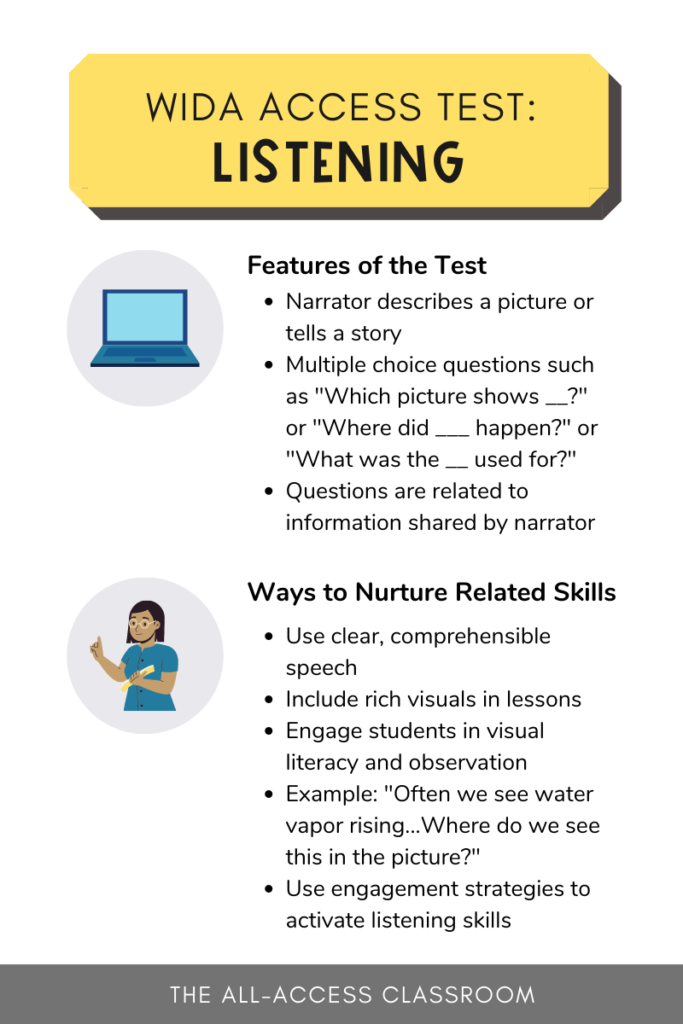
The reading ACCESS test will not offer narrator read-aloud support. Students will read a text (from a single sentence to a paragraph, based on grade level). Often the texts are based on a subject area topic such as a math word problem or scientific process. Given a picture or diagram, students will answer a multiple choice question. Typically, all information needed is found in the text.
To support reading skills, we can:
- Give students comprehensible text, followed by text-dependent questions (who, what, where, etc.)
- Give students tools and procedures needed to decompose and solve math word problems
- Encourage students to justify their thinking and reasoning with evidence from the text (i.e. What steps did you use? Why do you…? How do you know?)
- Develop academic vocabulary in all subject areas.
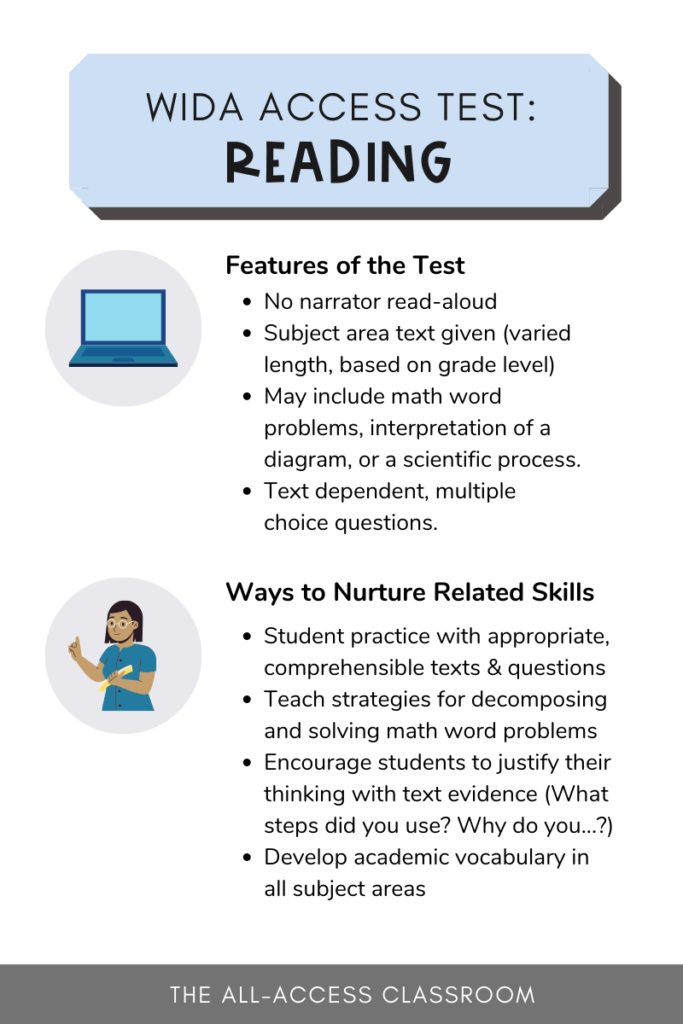
ACCESS Test Prep: Speaking
The speaking ACCESS test can be challenging for many students. It will require comprehension of content-related information, as well as voice recordings of item responses. If students have not had adequate supported opportunities for speaking practice throughout the school year, they may be hesitant, anxious, or embarrassed to produce the recorded responses needed.
In many cases, during the speaking test, students will hear a story (with visuals) or examine an image. They will then be given a prompt. When ready, they will record their response. Questions may be basic, such as “What do you see? How did she help them?” Or students may be asked to provide an extended response, such as retelling the story. They may be asked to describe a process, a prediction, or observation.
To support speaking skills, we can:
- Help students grow accustomed to using a tech application/tool to record academic thinking. Apps like Flip and Vocaroo can be helpful. Some platforms such as SeeSaw also include voice recording features.
- Provide frequent opportunities for students to respond to questions through oral discourse. Supportive sentence frames and low-stress contexts will encourage even new ELs to practice speaking. Structuring discourse through prompts and sufficient wait time are good practices.
- For beginning ELs, provide content-related flashcards with images, and ask them to point to/identify what they see.
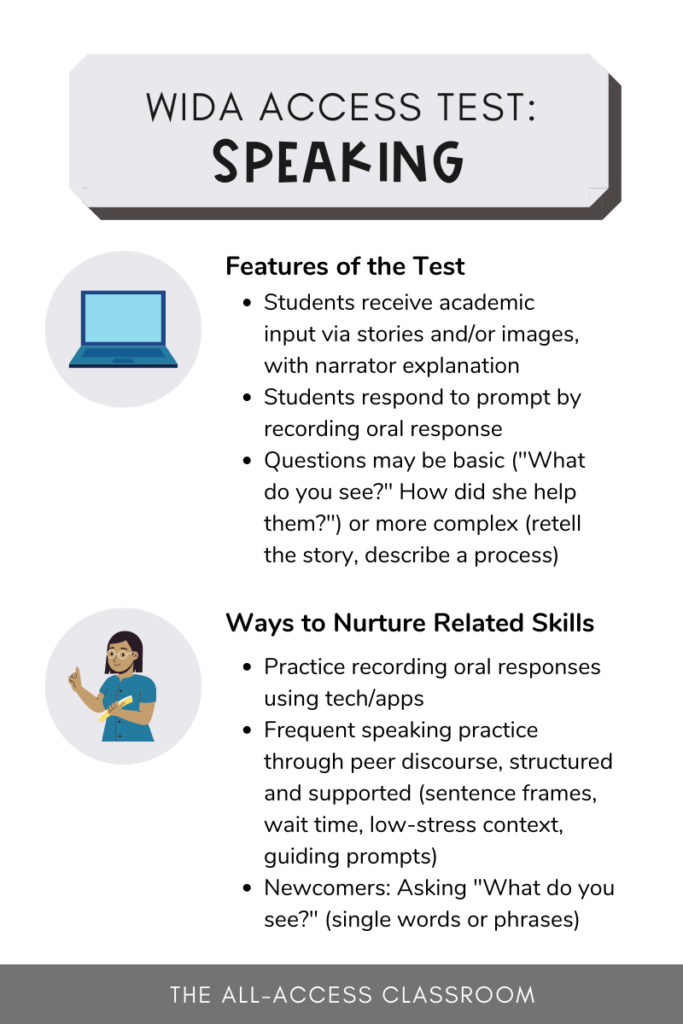
ACCESS Test Prep: Writing
Lastly, the Writing ACCESS test. At the primary grade levels, students will write single words or basic sentences about an image. They may be prompted to write what they see or what is happening. They may need to tell a story or write a report about a series of images, using sequencing words (first, then, etc.).
At higher grade levels, students may write to describe or make a list. They may be asked to write an extended paragraph/essay to compare and contrast two things. Sometimes, students are given an academic chart with interpretation questions. For extended responses, organization of ideas is important.
To support writing skills as part of ACCESS test prep, we can:
- equip students will prewriting and organizational strategies
- teach sequencing and other transitional words explicitly
- implement writing practice opportunities across the subject areas
- nurture ELs’ writing proficiency by encouraging gradually more complex text and language forms (clauses, descriptive language, compound sentences, etc.)
- teaching the various writing structures (narrative, explanatory, etc.)
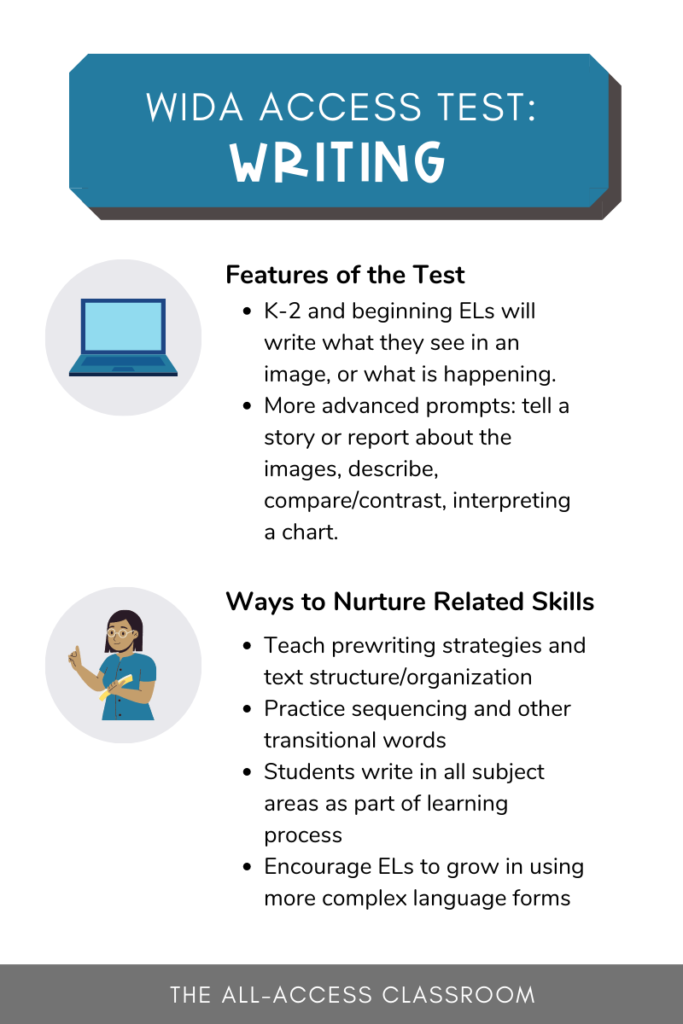
Opportunities for Practice as the WIDA ACCESS Tests Approach
Need some quick activities that will give students a taste of the test format and layout? There are WIDA ACCESS test practice resources available. WIDA has very accessible sample test questions and practice questions on their website. (See links below.) Additionally, some resource designers have created materials similar to the WIDA test, available on marketplaces like TPT. While we never want to “teach to the test,” these test practice activities can be helpful leading up to the ACCESS test.
Final tips
These ACCESS tests are chock-full of rich academic language. It is imperative that throughout the school year, content-area teachers embed explicit vocabulary instruction. Mastery of Tier 2 and Tier 3 words will really help students with comprehension of test items.
Let’s consider that the ACCESS test was designed to align with the very same standards, skills, and features of the WIDA ELD standards. Why not incorporate goals, language, and awareness of these standards throughout the year? Language functions and usage will be at the forefront of student learning. Abundant language practice opportunities will spring up!
The bottom line: The best way to prepare your multilingual learners for the WIDA ACCESS test is to support their language development throughout the year! Do this by providing:
- Regular engagement opportunities
- Comprehensible input
- Scaffolded activities which require specific language use
Yep, the process of administering the ACCESS tests can take a while, and can require serious school-wide effort. So I am sending you all my best wishes for everything to go smoothly! Remember that it will all be worth it when you get those valuable score reports in-hand!
Interested in learning more about some of these topics? Check out:
Building vocabulary using a Frayer Model Template
Rubrics for speaking and writing (helpful for reference year-round!)
Find me on Instagram or Facebook!


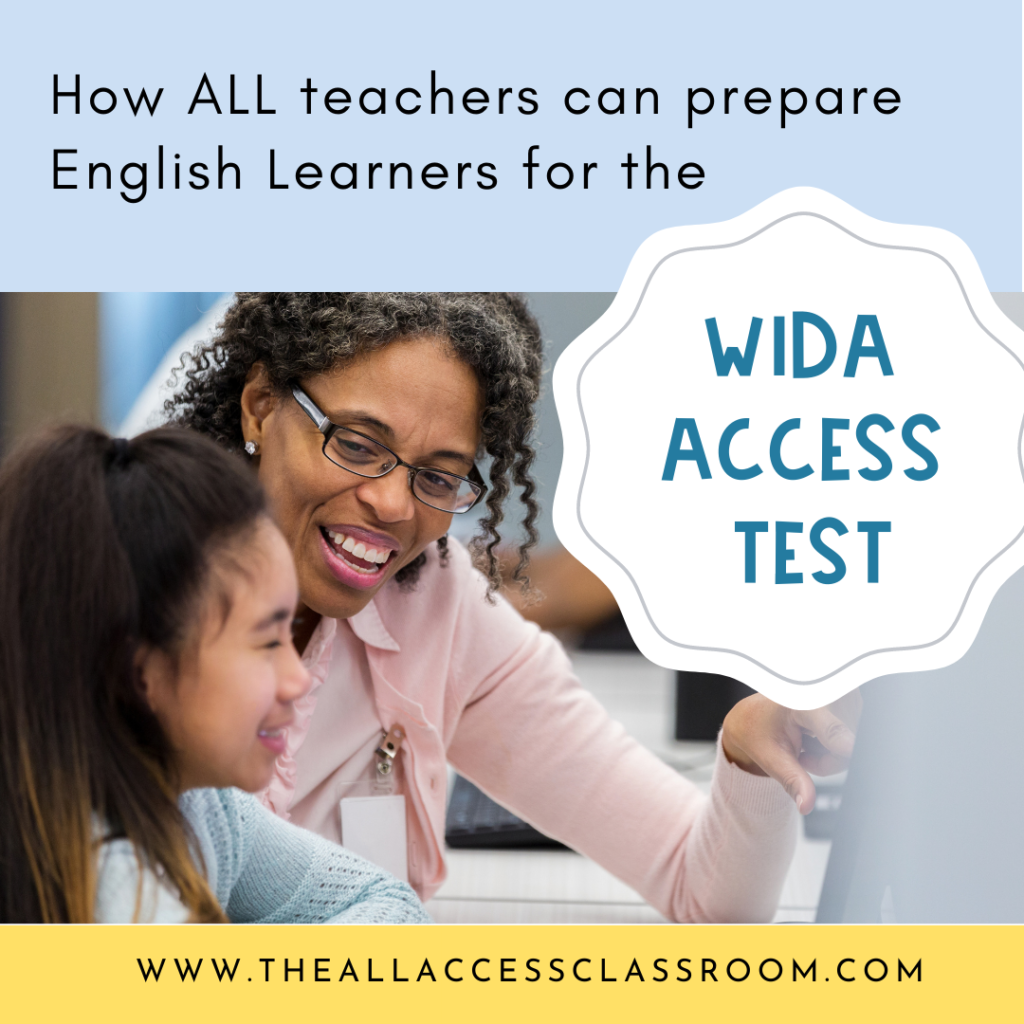
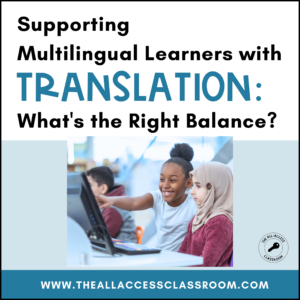
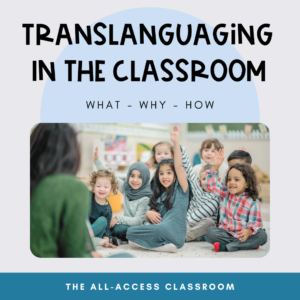


One Response
Thanks.